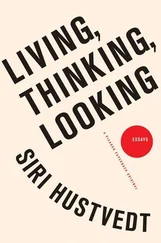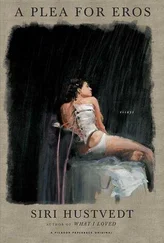It was there with Felix, too, the thing, but it wasn’t his fault. I understand that now. It was there long before Felix. Let him sleep. Walk softly. Defer. Don’t upset him. He is fragile, fragile and somehow dangerous. Felix always deserves what you don’t. Why? Mysterious feelings: ingrown, automatic, thoughtless. Before words. Under words.
What is early memory, I ask you?
It is with considerable difficulty that I remember the original era of my being; all the events of that period appear confused and indistinct.I
Mine, too.
The mind is its own place and in itself can make a heav’n of hell, a hell of heav’n.II
Can I rely upon the pictures I see or are they reconfigured to a degree that obscures all sense?
My Life had stood — a Loaded Gun.III
I am wild on paper. I am bestial. And then I must hide and, with the thick black crayon, I rub out every line. I blacken the page so they will never see what I have drawn, what I have done.
Why do I feel there is a secret I carry in my body like an embryo, speechless and unformed, beyond knowing? And why do I feel it might erupt in a great blast if not checked? It must be easy, so easy to fill in that damp, throttling unease with words, to write the disturbance, to write a story to explain the why of it.
I was in my crib.
I was standing on the floor.
The curtains were drawn, and I had to climb onto a chair to pull aside the fabric and look outside into the street.
I saw his feet in front of the door.

The memory begins to form itself from the cloud of unknowing. The shapeless takes shape and soon there is a smothered articulation — ominous and meaningful.
Shame arrives before guilt.
But there is no going back, Harry. The mind is its own place, and it bears us backward and forward. It has its own architecture of the past that comes from real rooms and real streets, but they are made over and over again in time and now reside within, not without. Once those places were filled with the noise of garbage trucks and sirens and the sentence fragments of chattering pedestrians and the odors of the moving seasons, but the dense visions and clamor and smells have been simplified into interior mental codes grown stiff with words. The future is made of that same stuff — elemental spaces we inhabit with wishes or fears. Why so many fears? There is no single story in that foggy region of childhood to explain you, Harry.
I think of Bertha, Bertha Pappenheim, alias Anna O.
It is frightening what we imagine and what we make by imagination.
She, Anna O., receives Dr. Breuer, the physician who has supposedly cured her, who has used the cathartic method, the first talking cure, but she, Bertha, named it, not he. She named it. In a letter to Stefan Zweig in 1932, Freud provided a coda. And when Breuer comes into the room, Bertha is clasping her belly and writhing in pain. What is the matter? he asks. What has happened? And she says, Now comes Dr. B.’s child.
It is the thing they have made together. Look at it.
The good doctor runs in terror.
The good doctor does not run in terror. It is a myth.
They rewrote her.
She would rewrite them. In courage.IV
I dream of Dr. F.
The suppressed thing. The thing that comes up. She has named it: Dr. B.’s child. It will out.
Where is the borderland between memory and hallucination?
We make images spontaneously. They will out.
For as long as I can remember they have come to me at night before I sleep. They used to frighten me, the horrors of that self-generated cinema, like dreams but not dreams, a threshold reality between waking and sleeping; a limen that should be named, but isn’t. I am not inside the screen but outside, watching their exploits, and I have come to love them. Every night I wait for them. The brutes rise up, fierce and menacing, their teeth bared and their noses leaking pink snot as they lumber over brimming blue hills. They are never still but in constant metamorphosis, mouths become chins, eyes turn into welts, boobs and cocks drop to the ground and molt into new devils or vanish in festering heaps of color. Hair floats behind a disfigured head in curling knots or garlands, but I also see the innocent and the lackadaisical, sweet children and well-formed adults; two dancers fornicate while airborne, and I smile at their rhythmical hips. A tiny man leaps from a cliff, and pure geometries of hard green and red and yellow melt into a riot of running lava. I have seen us all, Maisie and Ethan and Felix and me and my parents and Rachel fleeing past my closed eyelids on the screen, barely recognized but there nevertheless among the parade, as if my mind had retained the reels of an old movie. If only I could transfer those hypnagogic muses into paint or film or little kinetic sculptures. Where do they come from? Why one image and not another? Is it memory transmuted? Where do hallucinations come from in the brain? No one can say.
I hear the Barometer wheezing in the hall. I’m glad he’s back. I’m not sure where he goes for hours at a time. Proselytizing or schmoozing or just wandering? But I can hear his whistling tubes. Felix wheezed, too. And he coughed. My father coughed. Smokers all. Each man’s cough had/has its own moist rumble or dry rattle. Isn’t it odd that we can recognize a person’s cough, that phlegm loosened in bronchia has an idiosyncratic sound? My madman wheezes and coughs and has begun to scratch imaginary sores, which, with scratching, become real. I offered him a salve. In his notebooks he draws cities on fire and dragons and dervishes and circle upon circle and cryptic symbols and clouds, of course, and rain and snow and hail of various sizes. He has little interest in fair weather; he is my foul-weather friend.
I. The opening sentence of Chapter 11 of Mary Shelley’s Frankenstein .
II. John Milton, Paradise Lost , Book 1 (554–55). The words are Satan’s. In Notebook G, Burden notes, “Satan removes his mind from God. Heresy, of course. Hubris, of course. Modern, of course.”
III. The Complete Poems of Emily Dickinson , ed. Thomas H. Johnson (New York: Little Brown and Co., 1960), no. 754, p. 369.
IV. Bertha Pappenheim was the real name of Josef Breuer’s patient Anna O., whose case figures in Freud and Breuer’s Studies on Hysteria (1895). Her symptoms included tics, intense facial pain, loss of vision, memory lapses, and even a temporary inability to speak her mother tongue, German. Breuer’s treatment, along with other methods, included letting his patient talk and tell him stories. Pappenheim coined the name the talking cure in English. In the case study, Anna O.’s story ends with her cure, but the truth is far more complicated. Breuer handed his patient over to a Swiss sanitarium. Pappenheim still suffered from hysterical symptoms, although they were less dramatic than before her treatment with Breuer, and she was addicted to both morphine and chloral hydrate. See A. Hirschmuller, The Life and Work of Josef Breuer: Physiology and Psychoanalysis (New York: New York University Press, 1970), 301–2, and D. Gilhooley, “Misrepresentation and Misreading in the Case of Anna O.,” Modern Psychoanalysis 27, no. 1. After her release from the sanitarium, she was hospitalized three times over the course of the next five years.
In his letter to Zweig, Freud writes, “What really happened with Breuer’s patient I was able to guess later on, long after a break in our relations, when I suddenly remembered something Breuer had once told me. . On the evening of the day all her symptoms had been disposed of, he was summoned to the patient again, found her confused and writhing with abdominal cramps. Asked what was wrong with her, she replied, ‘Now Dr. B.’s child is coming!’ ” E. Freud, ed., The Letters of Sigmund Freud (New York: Basic Books, 1960), 67, my italics. From this memory Freud conjectures that Anna O. suffered from a hysterical pregnancy and that the sexual character of those symptoms caused Breuer to flee in fear. Ernest Jones later corroborates this version of events in his biography of Freud, as does Peter Gay in his. These interpretations of the evidence are disputed, however, and Burden appears to be well acquainted with the controversy. “They rewrote her. She would rewrite them. In courage” refers to Pappenheim’s later life as a feminist activist. In 1888, Pappenheim left the haute bourgeois life she had led as an Orthodox Jew in Vienna and traveled throughout Eastern Europe, fighting for and publishing works about the rights of Jewish women. In 1904, she co-founded the League of Jewish Women, which organized health-care facilities, vacation retreats, and youth homes, and offered career training for women. The League was dissolved on November 9, 1938. Many of its leaders were murdered in the camps. Burden may be referring to Pappenheim’s Last Will and Testament, in which she wrote: “If you remember me, bring a little stone, as the silent promise and symbol of the establishment of the idea and mission of women’s duty and women’s joy in serving unceasingly and courageously in life.” E. Loentz, Let Me Continue to Speak the Truth: Bertha Pappenheim as Author and Activist (Cincinnati: Hebrew Union College Press, 2007).
Читать дальше













